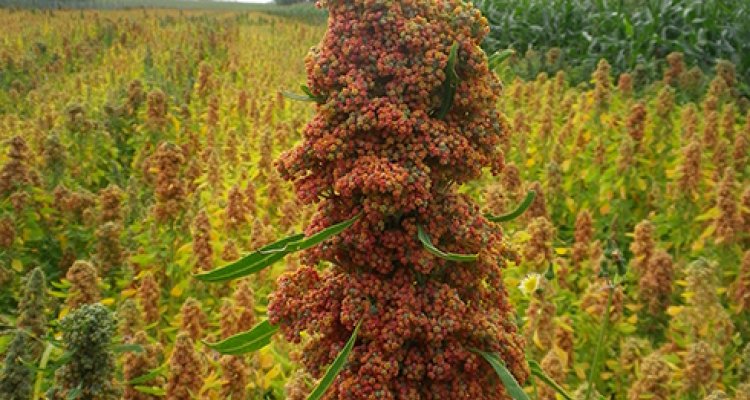
FAQ
Quinoa cultivation in the Netherlands
What is quinoa? How do you grow this crop in the Netherlands? And how big is the yield?
The demand continues to grow worldwide, and with the advent of new varieties, this originally South American crop can now also be grown in Europe. On this page you will find 10 questions and answers about the growing of this crop.
What is quinoa?
Quinoa (kien-wa) is an old crop with its origins in the Andes region of South America. A relatively large amount is grown in Bolivia and Peru. In the Netherlands, quinoa is also known as gierstmelde. The plant (Chenopodium quinoa) belongs to the chenopod family and is closely related to the weed white goosefoot. It is also closely related to spinach.
It is not a cereal, but it is sometimes called a pseudocereal. A pseudocereal is a dicotyledon plant that is grown in the same way as grain. The seeds are also used in the same way.
Can you grow quinoa in the Netherlands?
Yes, you can grow this pseudocereal in the Netherlands. In the early '90s, Wageningen UR conducted research into the potential for cultivation. This revealed that quinoa grows well in the Netherlands. Particular attention is required for weed control and harvest. Early this century, new varieties were bred which are better adapted to climate conditions in North-Western Europe. This has increased the scope for growing quinoa in Europe.
Is there organic growing in the Netherlands?
Over the past twenty years, organic quinoa has been grown in the Netherlands on a small scale. The price is exceptionally high. It may be attractive for companies to consider the cultivation of this crop. Since 2014, there is also non-organic cultivation the Netherlands.
Which varieties can you grow in the Netherlands?
The best-known new (saponin-free) quinoa varieties are Atlas and Pasto. Atlas is a slightly taller and leafier variety, and as a result produces a fairly massive plant with good weed suppression. Pasto is a somewhat shorter variety with smaller leaves, making it a more open crop. It is still too early to say which variety is best for growing here. At the end of 2014, the first yield figures for Dutch quinoa will become known from three locations. But besides yield, the quality and time of ripening also play a role in choosing the right variety.
When do you sow and harvest quinoa?
The crop can be sown from late March to early May. The time of harvest depends on the weather during the growing season, the variety and the time of sowing. Usually, quinoa is harvested between late August and late September.
How do you harvest?
Quinoa may be harvested using the same combine harvester used to cut and thresh grains, grass seed and other crops. The combine settings (sieving, air, drum, etc.) do need to be adjusted to the size of the seed. The seed is fine (the weight of a thousand seeds is 2-3 grams) and approximately the same size as grass seed.
How do you control weeds?
Weed control when growing quinoa is tricky. As yet, no crop protection agents have been authorised, which means weed control can only be carried out mechanically. Because the quinoa sprout is fairly vulnerable, harrowing is not recommended. Sowing at a row spacing of 25 cm or more offers opportunities for weeding. Weeding several times gives good control of the weeds between the rows. In addition, the weeds in the row needs to be removed manually before the crop closes up. Research is currently taking place into possible crop protection agents.
Which diseases occur in quinoa and how can you best control them?
It is known that various fungal diseases can occur, such as Pythium, Botrytis, Peronospora and Sclerotinia. The appearance of the fungi depends on the weather conditions and the variety. The most common fungal disease is downy mildew (Peronospora farinosa).
Most varieties are susceptible to this disease to a greater or lesser extent. Downy mildew causes yellowing and premature death of the leaves.
As yet, no fungicides have been authorised for the cultivation of quinoa, and the fungal diseases referred to can therefore not be controlled by means of crop spraying. It is important to take this into account when choosing a variety.
How do you fertilise quinoa?
The crop requires plenty of nitrogen and potash. Depending on the condition of the soil, adding fertiliser at 120-180 kg N per hectare is required to achieve a high yield. In addition, sufficient potash is also required. How much is not yet known and is one of the research questions in the cultivation study currently being conducted by Wageningen UR.
How many tons does a hectare of quinoa yield?
From the past we know that the pseudocereal can achieve a yield of 2-3 tons per hectare in the Netherlands. However, this was with the old varieties. How the three new varieties will perform in the Dutch climate is not known. We look forward to the harvest of 2014 with high expectations.
What are the economic prospects?
In the Netherlands, quinoa is known as a superfood. It contains large amounts of proteins and essential amino acids, and is rich in vitamins and minerals. Partly as a result, demand for the product is increasing. Currently, Bolivia, Peru and Ecuador are the largest exporters. They primarily export to the USA, France, the Netherlands, Germany, Canada, Israel, Brazil and Great Britain (FAO). At present, the supply is not sufficient to meet the worldwide demand. As a result, prices have risen sharply and the cultivation of the crop has become economically attractive. This will probably change as soon as variaties begin to be grown outside South America. In a few years' time, the market price is likely to start falling, but it will probably still continue to yield an attractive financial return.